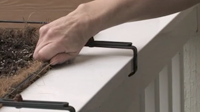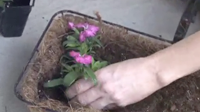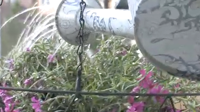Apartment Container Gardening – Plant A Garden On Your Balcony
Apartments don’t give you much space to work with, especially if you’re into gardening. But adding plants to your space can add a nice touch, especially if you have a balcony or other outdoor space. In this video we will give you the basics of container gardening so you can green up your thumb and your living space.
Container gardening will give you the ability to eat healthier with more fresh produce and herbs as well as help you be more thrifty with money and save money on expenses at the grocery store. If you also plant a nice selection of flowers, you’ll also be able to add some additional beauty to your apartment decor without having to spend any additional money.
- Potting Soil
- Pots
- Plants
- Coconut Liner
- Hanging Baskets
- Bracket
- Screwdriver
- Hand Trowel
- Watering Can

Purchase various potting containers.

Make sure that all hanging plants are secure before filling them.

Pick healthy looking flowers. Plants that hang down has they grow are perfect for hanging baskets.

Add potting soil.

Dig holes that are a little larger than the root clumps of the flowers you’re planting.

Place your plants in the holes and push some soil on top of the roots.

Water plants and once a day after.
Read Video Transcript
Just because you don’t have a house with a big backyard doesn’t mean you can’t enjoy a beautiful and bountiful garden. Even if the only space you have is an apartment balcony, you can still enjoy the benefits of container gardening in just a few square feet of space.
Today we’re going to talk about the simple joy of growing plants in containers, which is called container gardening. We’re going to transform this apartment balcony into a container garden oasis with some flowers and herbs using some basic gardening supplies that we picked up at our local independent home improvement retailer.
So let’s get started.
One of the major benefits of container gardening is that, unlike plants grown in ground, containers are portable. They can be moved around to add interest, moved inside during a cold snap or on extremely windy days, or even moved with you, if you decide to move.
As is the case when growing anything, getting the soil right is critical. The good news is that most potting soil mixes take the guesswork out of it. Potting soil is actually a mix of several ingredients, which generally includes peat moss, compost and perlite. Some mixtures also contain vermiculite. The mixture we’re using provides excellent drainage, nutrients and is known for its moisture holding-capabilities, which guards against the plant drying out due to under-watering. We’ll talk more about that later. What potting soil generally doesn’t contain is dirt. For more information on potting soil ingredients, be sure to check our Frequently Asked Questions for this video.
We’ll get started by examining our containers, which include two hanging baskets, and this attractive pot. One of our baskets will hang from a bracket fastened to the side of the building, and the other will drape over our balcony railing. Both have a lining made of shredded coconut husks.
First, we’ll make sure our bracket is secured tight to the wall and that all mounting brackets and hardware are in good shape, and not loose or cracked. We don’t want anything falling off our balcony. And these baskets will be much heavier when they are filled with soil and plants, especially after a watering.
While it’s still early in the planting season, we selected plants that look healthy. We also took into consideration the growing characteristics of our plants, noting whether they will trail or grow upright, and how big they will get when they are full size.
A rule of thumb is that you don’t want to plants that will grow taller than one and a half times the height of the container or it will look top- heavy. With that in mind, for the basket that will hang over the balcony railing, we chose dianthes and some herbs, such as parsley and thyme. For the hanging basket, we selected creeping phlox that will hand down from our pot, or trail, as it is called.
Now we’ll add the potting soil to our containers, filling each one until the potting soil is a couple inches from the top of the container.
Before we start digging any holes for planting, we’ll first arrange the plants first to make sure they are spaced properly and that we will like the design of the arrangement. It’s usually OK so space plants closer together in a container arrangement, as long as the roots have room to grow and expand.
One we are comfortable with the arrangement, we’ll dig holes using our garden trowel or a cultivator. The holes should be a little bit larger than the root balls of our plants. Place the root ball in the hole and cover with potting soil. Press down around the roots gently to make sure they are bedded.
Don’t get ahead of yourself. Plant one hole, then move on to the next.
After everything is planted in both baskets, add more potting soil and even some compost if you like, and fill the container to within an inch of the top. Now we can hang them in place.
For our pot, we’ll basically repeat the process. But before adding potting soil, we’ll first add rocks to the bottom of the pot to help with drainage.
Now we’ll give our plants a good drink, watering the baskets until water drips out of the bottom of the coconut liner. For the pot, we’ll water until we see it collecting in the tray at the bottom. (I don’t know how this procedure will work because I don’t know what type of pot it is. Please explain process—Scott) You may want to place an old dish or small baking pan under pot to collect excess water.
Watering your container garden can depend on a number of factors, including the size of the pot or container and how much sun the area receives. Containers are notorious for drying out quickly because there’s not a lot of soil to hold moisture. You should water your container garden plants at least once a day, and check more frequently if it’s hot or windy.
But keep in mind that over-watering can be just as detrimental to plants as under-watering and can lead to root rot. There should never be standing water on top of the soil.
Well there you have it. Your apartment balcony never looked so good, and you’ve got a new hobby that will continue to blossom over time.
Close Transcript
It’s designed to hold the bolts up and stay in place making it extremely easy to set the toilet. If you forget something you can pull the toilet back up and reset it on the same Sani Seal.
You’re right, it’s a great idea to green up a part of your house or just to get into gardening. I think it’s important to read in detail about the plants you’re thinking of planting, also consider coco soil as an all purpose soil for growing plants, that would be a great solution.
Growing plants with your kids is How To Eat Sunflower Seeds?
a great activity that is both fun and educational. It’s a great opportunity to teach them where the food we eat comes
Thank you so much! This is what I need to find.
I have a lot of ideas for my apartment and how to improve it and make it more comfortable, but everything requires a lot of money. I’m trying my hand at NFT investing, and to what extent. I realized now you can invest safer thanks to certification protocols such as Wakweli. These certificates also help fight fraudsters in the NFT market.
Slope 3 gets faster as u go, so u have to be very careful to prevent getting into a terrible crash.